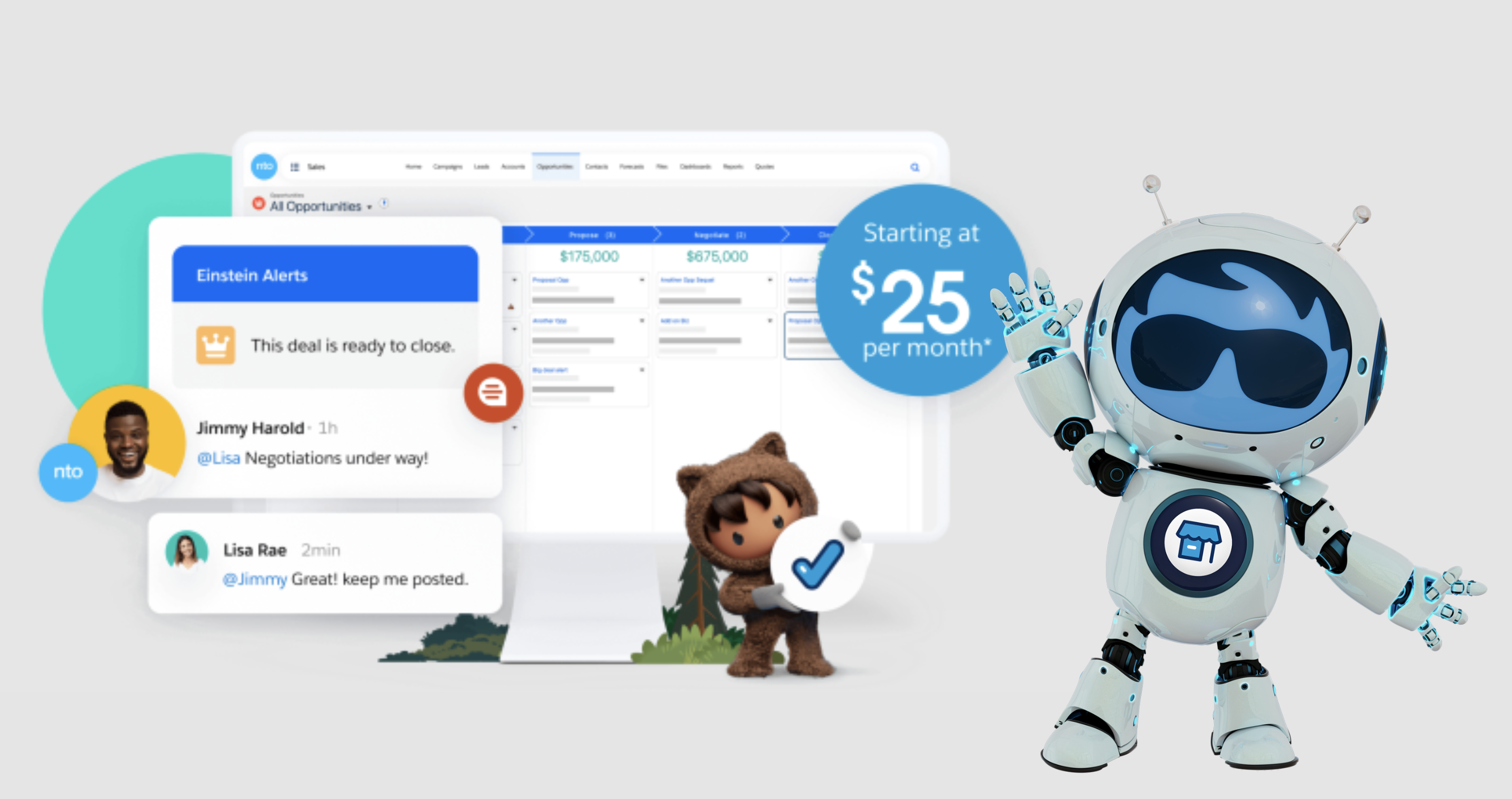As a small business owner, you have the potential to reach the masses. No matter if you’re a small or medium-sized business (SMB) or growing fast, you can take it to the next level and start selling online. It may be time to open up a digital shop.
Together, we’re going to learn the process of setting up an online store for your SMB, from the benefits of ecommerce to choosing the right platform. We’ll walk you through optimizing your store, tips, and best practices for promoting and marketing it — and managing and scaling operations to work for you. And, we saved the best for last with a quick step process to setting up your shop with Salesforce (by the end of the day).
Get ready to turn your small business into an ecommerce powerhouse.
Here’s the lineup:
- What is an ecommerce store?
- Benefits of creating an online store for small businesses
- Ecommerce platforms for your SMB
- Top 5 must-haves when managing your shop
- Tips to optimize your online store
- Promoting and marketing your store
- Open an ecommerce storefront with Starter in 7 steps
- Your online store is ready for business
What is an online store?
An ecommerce store, also known as an online store, is a digital platform that allows your customers to browse, select, and buy your products or services online. It serves as a virtual storefront for businesses, with a wider reach and the ability to sell globally, 24 hours a day, seven days a week.
For customers, ecommerce stores are in high demand. It’s easier for them to shop from the comfort of home, saving time and travel to physical stores. An ecommerce store is a digital bridge that allows your business to reach customers on a global scale. Currently, we’re at the crossroads of a local and digital hybrid of ecommerce, and we have to evolve with it to be successful.
Ecommerce stores offer a range of products and services, giving your customers more flexibility to find what they’re looking for. And, ecommerce stores typically offer a variety of payment options and secure checkout processes, gaining customer trust and satisfaction.
The key is to provide your customers with convenience, choice, and a shopping experience that is both efficient and enjoyable. First, you have to understand the fundamentals of an ecommerce store before you open up shop.
AI Tools for Small Business
Benefits of creating an online store for small business
By kickstarting an online store for your small business, you can access a global market, extending your reach beyond your wildest dreams. This new reach means more money, more funding, and more growth.
You’ll save big bucks without a physical storefront. Overheads are significantly lower than those of physical stores, with no requirement for commercial space means lower expenses. Online operations could mean less staff is needed, which saves you money, but it’s always nice to have a team for growth. You can then invest in product development, marketing, and customer service, contributing to the core of your business.
And, it’s yours to personalize. Customization of the online store’s design, layout, and content is at your fingertips, allowing for a more authentic brand identity.
And, oh, the data you gain having it all online, is worth it alone. The valuable customer insights through website analytics are a must-have, giving you an inside scoop on your customer’s behavior, preferences, and buying habits. This way, you can make informed decisions, optimize your marketing strategies, and continue doing what you do best.
Ecommerce platforms for your SMB
Ready to get started? The next step is to choose the ecommerce platform for your small business. These platforms provide a suite of features to manage an online store, including website creation, product listing, payment processing, and customer service. You’ll want to consider the following;
- Ease of use: how intuitively and efficiently you can navigate and manage the ecommerce platform.
- Scalability: the platform’s ability to grow and adapt with your business, handling increased traffic and sales.
- Features: the range of tools and functionalities offered by the platform for managing an online store.
- Pricing: outlines the costs and plans associated with using the ecommerce platform’s services and features.
Each platform out there offers different customization levels, pricing models, and integrations, allowing you to choose one that best fits your business needs and budget. By leveraging these platforms, SMBs can expand market reach, enhance customer engagement, and increase sales efficiency.
Start selling online with Starter Suite.
Set up your storefront, engage customers, and drive growth using an all-in-one platform with integrated tools for every step of the journey.



Top 5 must-haves when managing your shop
Next up, we’ll explore the strategies needed to help you maintain efficiency, great customer service, and growth as your business expands — because it will.
1. Customized commerce
Having a customized commerce storefront allows you to tailor the shopping experience to your unique brand identity, making a strong first impression. By offering personalized product recommendations, seamless navigation, and a visually appealing design, a custom storefront can help user experience and increase sales. It provides the flexibility to integrate specialized features and functionalities that cater to your needs, such as advanced search filters or interactive elements, ultimately setting the business apart from generic, one-size-fits-all solutions.
2. Customer relationship management (CRM)
By implementing a CRM system, you can centralize customer data, monitor interactions, and deliver personalized experiences. Review customer feedback, reviews, and social media mentions to get valuable insights into your customer’s needs. This type of intelligence helps to refine product offerings, and customer service, and gains repeat business.
3. Data Analytics
Employ analytics tools to monitor key performance indicators (KPIs) like website traffic, conversion rates, and average order value. Scrutinize these metrics to spot trends, fine-tune campaigns, and make informed decisions that will elevate your store’s overall performance.
4. Integrations
Imagine the automation of financial processes through integration with accounting software, or the provision of seamless customer service through a linked customer support platform. By using this easy technology, you can simplify tasks, lower manual work, and direct more resources to the growth of your business.
5. Scalability
As your business grows, you’ll need to manage traffic, orders, and product offerings. Select an ecommerce platform that can expand with you and adapt to your needs. Regularly assess your store’s performance to find any obstacles and make the necessary upgrades for expansion.
Create an online store in 7 steps
Opening your online store on Salesforce using the Starter Suite involves several key steps to ensure you effectively leverage the platform’s capabilities for e-commerce. Here’s a step-by-step guide to help you get started:
Step 1: Sign up for Salesforce Starter Suite
First, you need to sign up for the Salesforce Starter. The Starter Suite is designed for small businesses and includes essential CRM and commerce features.
Step 2: Customize your store’s design
Customize the look and feel of your online store. Use the built-in templates and design tools to create a professional and brand-aligned storefront. Ensure the design is user-friendly and optimized for various devices, including mobile and tablets.
Step 3: Import your product catalog
Add products manually or import them in bulk using a CSV file. Include detailed descriptions, high-quality images, prices, and any other relevant information for each product. Organizing your products into categories will also help customers browse your store more easily.
Step 4: Set up your CRM
Customers are up next! Use Salesforce’s CRM capabilities to manage your customer relationships. Set up customer profiles, segment targeted marketing, and implement automated workflows for common tasks like follow-ups and thank-you emails.
Step 5: Configure your store settings
Log in and familiarize yourself with the dashboard and available tools. Configure your store settings and add your products. Set up payment gateways, tax calculations, shipping options, and other operational details — it’s that easy.
Step 6: Activate your marketing campaigns
Use Salesforce’s marketing tools to create and launch promotional campaigns. You can set up email marketing, social media promotions, and paid advertising campaigns through the platform. Analytics are built in to track the effectiveness of your campaigns and make data-driven adjustments.
Step 7: Test and launch your store!
And, with the click of a button, your store can be open for business. Continue to optimize it in real-time, by adding new products and updating your brand, using the built-in AI to measure your feedback and metrics. That’s just six steps to selling online.

Tips to optimize your online store
Optimizing your online store is crucial for enhancing user experience and boosting sales. By following these tips, you can create a more engaging online shopping experience that attracts new customers and keeps them happy:
- Improve website speed: Ensure your website loads quickly to reduce bounce rates by using compressed images and videos, and hosting on a high-speed site. Use tools like Google PageSpeed Insights to identify speed issues.
- Simplify user experience: Simplify navigation, keep the design clean and attractive, and be sure that your search function is effective.
- Add your apps: Integrate your ecommerce store with other systems to streamline your operations and boost efficiency. Connect your store with accounting software for financial management, or integrate with customer service platforms for support requests.
- Use high-quality product images and descriptions: Use high-resolution images and accurate product descriptions. This helps reduce cart abandonment.
- Offer multiple payment options: Include various payment methods such as credit cards, PayPal, and digital wallets for different (safe) preferences.
- Streamline the checkout process: Minimize the number of steps in the checkout process to make it as easy as possible. This reduces cart abandonment.
- Add reviews and testimonials: Display customer reviews and testimonials to build trust and influence buying decisions.
- Offer personalized recommendations: Use data analytics to offer personalized recommendations and promotions based on customer behavior and preferences.
- Use AI-powered customer support: Provide multiple support channels like live chat, email, and phone. Quick and helpful responses can boost customer satisfaction.
- Go mobile: Make sure your website is mobile-friendly. A responsive design adapts to different screen sizes, providing a better browsing experience.
And, be ready to scale. Your ecommerce store needs to be designed for growth. As your business grows, your store must be ready to handle it all — more traffic, more orders, and more products (and more money!). Regularly assess your store’s performance, and look out for any constraints. You can do all of this with a small business CRM — and this webinar will help you set it up.

Promoting and marketing your store
With the competition in the ecommerce landscape, you need strategies to increase your store’s visibility and attract customers. Here are some methods to help you promote and market your online store.
Social media marketing presents an opportunity for you to engage with your audience and be with a community around your brand. By creating content, sharing product updates, and using social media advertising, you can drive mega traffic to your online store.
Search engine optimization (SEO) is a great way to build your store. Optimize your website content, product descriptions, and images with relevant keywords to boost your store’s visibility in search engine results pages. Implement technical SEO practices, such as a mobile-friendly site and swift loading times, to rise in the rankings.
Email marketing, always a good go-to, is perfect for lead nurturing, customer retention, and sales. Construct your email list by offering discounts or exclusive content, in exchange for customer email addresses. Send regular newsletters to spotlight new products, promotions, and informational content.
Remember to consistently monitor and analyze your marketing efforts to identify what works best for your business and make necessary adjustments to optimize your marketing campaigns.
Your online store is ready for business
With Salesforce Starter Suite, you can open your digital doors at any time. There are so many tools and resources available as you open up your shop. Here are a few to get you started:
- Webinar: Start Selling Online With Storefronts on Starter, Pro, and Foundations
- Trailhead: Build a Front-end Ecommerce site
- How to Build an Eccomerce Website That Converts
Get your online shop open today, and make money tomorrow by getting started with Starter Suite.
Get started with commerce for small business
Commerce for small business is here and it’s easier than ever to get set up.



































